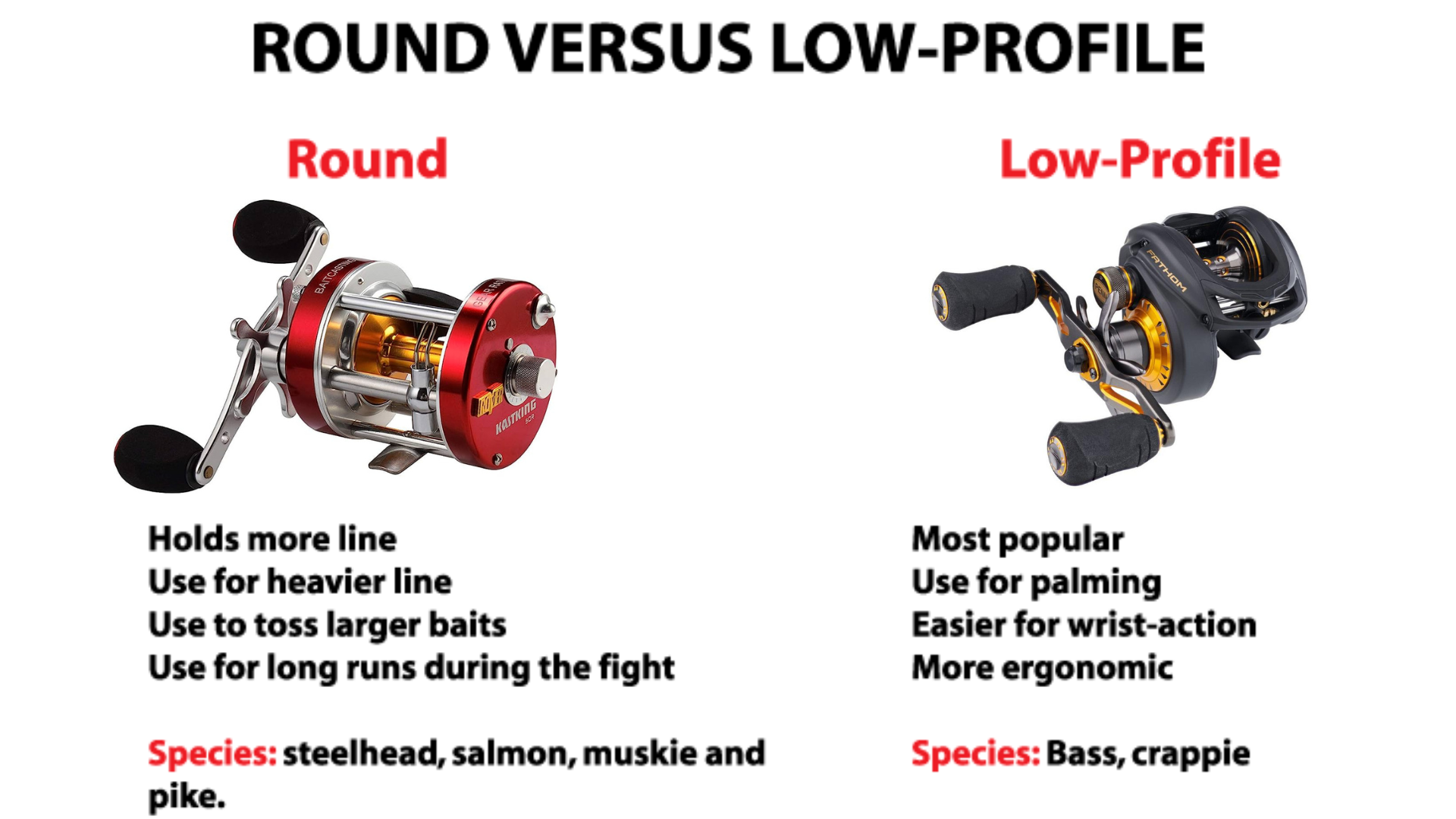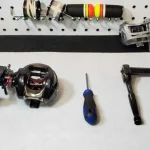Getting your baitcasting reel ready for bass fishing might seem a bit tricky, but don’t worry; we’re here to break it down for you. Most baitcasters, these days, come with three common features: a spool tension knob, a braking system, and drag.
Let’s start with the basics of setting up these crucial components, so you can make the most of your fishing reel. Whether you’re a seasoned pro or just starting with a brand-new reel, these steps will guide you. Keep in mind that as you gain more experience, your settings may evolve, but the fundamental principles we’re about to cover will remain the same.
The Allure of Baitcasting Reels
Baitcasting reels offer an enticing blend of precision and power. Anglers are drawn to their ability to cast heavy lures accurately, making them the weapon of choice for many fishing enthusiasts. However, without the proper setup, even the most seasoned angler can end up in a tangle of frustration.
Why Proper Setup Matters
The first step is understanding your baitcasting reel. Familiarize yourself with components like the drag system, spool tension, and brakes. Adjust the spool tension knob to find that delicate balance between free spooling and avoiding dreaded bird’s nests.
When you put your fishing line on the reel, make sure it goes on smoothly and evenly. This way, you reduce the chances of having tangles when you cast your line. Also, think about picking the right fishing rod that goes well with your reel. Make sure they match in terms of strength and how flexible they are. When they work together well, your fishing gear will perform at its best.
Here, we will discuss the complete process of baitcasting reel setup. We will explore each component in detail, offering tips and tricks along the way. So grab your reel, let’s get started on the path to baitcasting mastery.
Choosing the Right Baitcasting Reel
Setting up a baitcasting reel requires a careful selection process and an understanding of various factors to optimize your fishing experience. Let’s dive detailed discussion of baitcaster reel setup.
In the start, you have to choose the most suitable baitcasting reel for your needs, also that perfectly fits in your hands. There are two main types of reels to consider:
Types of Baitcasting Reels
1. Low-Profile vs. Round Reels: Low-profile reels are compact and lightweight, ideal for precise casting. Round reels, on the other hand, offer more line capacity and power for heavy-duty applications.
2. Gear Ratios: What’s Best for You: Gear ratios determine how fast the spool turns. Higher ratios, like 7.1:1, retrieve line quickly, while lower ratios, like 5.4:1, provide more torque for big fish battles.
3. Left or Right: Picking Your Reel Hand: Choose a reel that matches your dominant hand. Left-handed reels are reeled with the left hand, while right-handed reels are reeled with the right.
4. Matching Your Reel to Your Fishing Style: Consider the type of fishing you’ll be doing. Are you casting heavy lures or finesse baits? Different scenarios demand specific reel features.
5. Freshwater vs. Saltwater Considerations: Ensure your reel is built to withstand the corrosive nature of saltwater if you plan to fish in the ocean.
6. Lure Weight and Power Matching: Match your reel’s power rating to the lures you intend to use. This ensures smooth casting and prevents line breakage.
By carefully selecting the right baitcasting reel and understanding its features, you lay the foundation for a successful fishing trip.
Read Full Article How to Choose Best Baitcaster
Essential Tools and Equipment
Must-Have Tools for Baitcasting Reel Setup
Before you start, you have to keep your essential tools ready for setting up baitcasters in a way, the way we expect to have a successful fishing trip.
1. Wrenches, Screwdrivers, and Allen Keys: These tools are your ticket to opening up your reel and making precise adjustments. Different reels may require different types and sizes of these instruments.
2. Line and Spooling Essentials: A smooth and trouble-free cast begins with the right fishing line. Select the line that suits your target species and load it onto your spool. Don’t forget to tie a secure knot.
3. Oils and Grease for Smooth Operation: Keep your reel’s moving parts well-lubricated. A drop of oil here and a dab of grease there will keep your reel running smoothly, extending its lifespan.
Once you have gathered your tools and equipment, Now this is the time you are going to setup your baitcaster. Take it step by step, adjusting the spool tension, brakes, and drag settings to match your fishing style. With the right tools and a little know-how, you will perform better on waters while fishing for Bass.
Step-by-Step Setup Guide
1. Adjusting Spool Tension
Start by fine-tuning the spool tension knob. This controls the speed at which line is released during a cast. It should be set just tight enough to prevent backlashes while allowing for smooth casting.
2. Setting Brake System
Depending on your reel, you may have a magnetic or centrifugal brake system. Adjust these to match your casting style and the weight of your lure.
3. Drag System Calibration
Fine-tune your drag system to ensure it’s appropriately set for the target species. This ensures a smooth line release when you hook a fish.
By meticulously prepping your reel and following this step-by-step guide, you’ll be ready to hit the water with confidence, knowing your baitcasting reel is primed for success.
Prepare Your Gear for Action
To master the art of baitcasting, you must begin with the essential steps that prepare your gear for action. This involves reviewing manufacturer instructions, meticulously cleaning, and lubricating your reel.
1. Reviewing Manufacturer Instructions
Begin by carefully reviewing the manufacturer’s instructions specific to your baitcasting reel model. These guidelines often contain valuable insights and tips tailored to your gear.
2. Cleaning and Lubricating Your Reel
A well-maintained reel is the cornerstone of smooth operation. Disassemble your reel, clean all components, and apply the appropriate lubricants to ensure every part moves seamlessly.
Spooling Line Like a Pro
When it comes to baitcasting reels, achieving peak performance starts with the meticulous process of setup. Let’s discuss the art of spooling line like a pro and securing it with precision.
Begin your journey to baitcasting reel mastery by selecting the right fishing line. Factors like line weight and material matter, so choose wisely.
1. Securing Line with the Arbor Knot
To ensure a firm grip on the spool, start by tying an Arbor Knot. Wrap the line around the spool arbor, pass it through the loop, and cinch it down tightly.
2. Loading Line onto the Spool with Precision:
Maintain even tension as you load the line onto the spool. An erratic spooling job can lead to nasty tangles down the line.
Once your line is securely in place, it’s time to fine-tune the baitcasting reel settings to match your casting style and the lures you plan to use. Pay attention to the spool tension, brake system, and drag settings. Each tweak can make a world of difference in your casting accuracy and control.
With your baitcasting reel set up like a pro, you will be ready to tackle any angling challenge that comes your way. Tight lines and happy casting!
Deciphering Brake Systems
Achieving the finesse required for baitcasting success hinges on mastering the intricacies of your reel’s setup. Let’s embark on a journey to dial in the brakes and tension, ensuring you cast with precision.
Understanding the core of baitcasting mastery begins with comprehending the diverse brake systems at your disposal.
1. Fine-Tuning Brake Settings
Modern baitcasting reels offer a range of brake systems, such as magnetic and centrifugal. Delve into your reel’s manual to discern which one suits your casting style best.
2. Setting Spool Tension for Control
The spool tension knob acts as your control center. Adjust it until you find the sweet spot – tight enough to prevent backlash but loose enough for smooth casting.
By mastering the art of dialing in the brakes and tension, you will unleash the true potential of your baitcasting reel. Prepare for precision casting and more successful angling adventures.
Finding the Perfect Rod Match
Setting up a baitcasting reel is an art that can elevate your angling game to new heights. It all begins with attaching and adjusting the reel to your rod, ensuring a seamless union between the two.
Before learning the basic setting up your baitcaster, consider the best suitable rod which matches your reel and your fishing style. The synergy between your reel and rod is paramount for optimal performance. Pay attention to factors like power, action, and length to ensure they complement your fishing style.
Mounting the Reel with Confidence
With your ideal rod in hand, it’s time to mount the reel with confidence.
Follow these steps:
1. Secure the Reel Seat
Slide the reel into the reel seat, aligning it with the rod’s guides. Make sure it fits snugly but doesn’t overtighten.
2. Tighten the Reel Clamp
Use the reel clamp to secure the reel to the rod. Ensure it’s firmly in place to prevent any wobbling during your casts.
Tweaking Reel Position for Comfort
The final touch involves tweaking the reel’s position for ultimate comfort. Experiment with the placement until it feels natural and balanced in your hands. This step is crucial for long hours of fatigue-free fishing.
By following these steps and giving due consideration to your rod-reel partnership, you will set up your baitcasting reel for success, casting with precision and comfort on every angling adventure.
Testing and Tweaking Your Setup
Setting up a baitcasting reel is more than just a routine task, It is an art that demands finesse. Let’s dive into the detailed overview, from testing and tweaking your setup to troubleshooting common hiccups for a seamless fishing experience.
Before hitting the water, it’s essential to ensure your baitcasting reel is finely tuned:
1. Practicing Precision Casting
Begin by practicing your casting technique. This not only hones your skills but also helps you understand how your setup responds to different casting styles.
2. Gradual Adjustments for Optimal Performance
Make small, incremental adjustments to your reel’s settings. Start with the spool tension, fine-tuning it to find the sweet spot between control and distance.
Troubleshooting Common Hiccups
Even the most seasoned anglers encounter challenges. Here’s how to troubleshoot common hiccups:
1. Backlash Prevention
If you face backlash issues, consider increasing the spool tension slightly. It can help control line release during casts. When a bird’s nest occurs, don’t panic. Gently remove the tangle and re-adjust your spool tension for better control.
Read More For How To Prevent Backlashes
2. Line Slippage
If your line slips on the spool, re-spool it while ensuring even tension. Uneven spooling can cause this problem.
By testing and tweaking your setup and mastering the art of gradual adjustments, you’ll unlock the full potential of your baitcasting reel. With the knowledge to troubleshoot common hiccups, you’ll be well-prepared for a rewarding fishing adventure.
Keeping Your Reel in Top Shape
Mastering the setup of a baitcasting reel is a skill every angler should possess, but equally important is knowing how to keep your reel performing at its peak. Here, we’ll not only guide you through the setup process but also share tips on maintaining your prized reel.
1. Post-Fishing Cleanup Ritual:
After a successful day on the water, make it a habit to clean your baitcasting reel thoroughly. Remove any dirt, debris, or salt residue that might have accumulated during your fishing expedition.
2. Periodic Lubrication and Maintenance:
Just like any piece of machinery, your baitcasting reel needs regular care. Periodically, apply the right lubricants to ensure all moving parts operate smoothly. Pay extra attention to the gears, bearings, and drag system.
3. Proper Storage Techniques:
When your reel isn’t in use, store it in a cool, dry place. Consider using reel covers to protect against dust and potential damage. Proper storage ensures your reel’s longevity.
By combining the art of setting up your baitcasting reel with a commitment to post-fishing cleanup, periodic lubrication, and proper storage, you not only enhance its performance but also extend its lifespan, ensuring many more successful angling adventures in the future.
Mastering the Art of Casting
Setting up a baitcasting reel is more than just a routine task; it’s a gateway to advanced angling mastery. Beyond the basics, there are advanced tips and techniques that can take your casting game to the next level.
1. Harnessing the Power of Thumb Control:
To cast like a pro, learn the delicate art of thumb control. Your thumb can regulate the spool’s speed, preventing backlashes and ensuring a smooth release.
2. Achieving Maximum Distance and Accuracy:
Precision casting isn’t just about distance; it’s about hitting your target. Practice and patience are key to mastering accuracy while achieving those impressive long-distance casts.
Fine-Tuning Brake and Tension Systems
Adapting to Changing Fishing Conditions: Fishing conditions can change rapidly. Be prepared to adjust your brake and tension systems on the fly to adapt to changing wind, water, and lure conditions.
Tailoring Settings for Different Lures: Different lures require different settings. Fine-tune your brake and tension systems to match the weight and aerodynamics of your lures for optimal performance.
Exploring Upgrades and Accessories
Enhancing Performance with Add-Ons: There are numerous add-ons and accessories that can elevate your baitcasting reel’s performance, from upgraded handles to specialized knobs.
When to Consider an Upgraded Reel: If you’re serious about angling, don’t shy away from considering an upgraded reel. Advanced reels offer features and performance capabilities that can make a significant difference in your fishing success.
By delving into these advanced tips and techniques, you’ll not only set up your baitcasting reel with confidence but also cast with precision, adapt to changing conditions, and explore enhancements that can take your angling prowess to new heights.
Finding Best Budget Baitcaster? Best Baitcaster Under $200
Conclusion
In the world of fishing, mastering the art of setting up a baitcasting reel is not just a technical skill; it’s a gateway to the sheer joy of angling. As we conclude our journey through the intricate process of baitcasting reel setup, two key elements come to the forefront – the joy of a well-tuned baitcasting reel and the ongoing journey of improvement.
The Joy of a Well-Tuned Baitcasting Reel
Imagine the satisfaction of casting your line with precision, the smooth release of the spool, and the thrill of reeling in a prized catch. A well-tuned baitcasting reel transforms fishing into a finely-tuned experience. It’s the tool that allows you to cast with accuracy, control, and confidence, enhancing every angling adventure.
The Ongoing Journey of Improvement
But the story doesn’t end here. As an angler, you’ll quickly learn that improvement is a journey without a final destination. You’ll constantly refine your techniques, adapt to changing fishing conditions, and explore upgrades to enhance your reel’s performance.
The joy of a well-tuned baitcasting reel is not just in its precision but in the pursuit of improvement. It’s a journey that keeps you engaged, learning, and growing as an angler. So, embrace this ongoing journey, cherish the satisfaction it brings, and let the love of fishing drive you forward.







